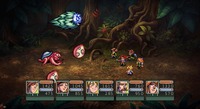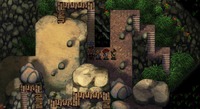|
|

|
PLATFORM
|
PC
|
BATTLE SYSTEM
|

|
INTERACTION
|

|
ORIGINALITY
|

|
STORY
|

|
MUSIC & SOUND
|

|
VISUALS
|

|
CHALLENGE
|
Hard
|
COMPLETION TIME
|
20-40 Hours
|
|
OVERALL

|
+ Looks and sounds great for the Genesis
+ Plenty of content
- Fighting regular enemies is a chore
- Long stretches away from security
- Interaction is antiquated
|
Click here for scoring definitions
|
|
|
Sega's most popular piece of hardware around the world was the Genesis/Mega Drive, which enjoyed a massive library of titles in the 16-bit era. Like its contemporaries though, the machine's support dried up in the late 90s as more powerful hardware filled the market. Developer WaterMelon refused to let the Genesis stay dead, and after years of development Pier Solar and the Great Architects found its way into the hands of eager fans in 2010. For those understandably reluctant to part with the money necessary to obtain a specially produced Genesis cartridge plus packaging in the current age, the former Genesis-exclusive is now available on many digital platforms. WaterMelon seems to have been under the impression that gamers wanted something that could have fit in with the rest of the Genesis's RPG library without displaying many of the improvements in design found in more recent years, and that is what Pier Solar delivers.
Hoston, Alina and Edesott are a trio of teenagers in the peaceful town of Reja. Hoston's initial goal of finding an obscure medicinal plant to aid his father also unearths ancient ruins, about which Alina's archaeologist father has ensured she is well informed. Broaching the subject proves to instigate a family crisis, and Alina determines to run away rather than deal with her unhappy family environment any more. Her two friends follow, and eventually stumble upon the last survivors of an ancient species. Less pleasant people are also after what those survivors know, and the conflict that arises proves to have enormous ramifications.
Pier Solar is a successful attempt to recapture how plot developments took up considerably less time in the 16-bit era. Unfortunately this tale fails to reach the heights such enduring titles as Phantasy Star IV and Final Fantasy VI achieved. While dialogue exchanges err on the side of brevity instead of an information overload, this often results in conversations that seem to cut off too quickly without exploring the situation very well. The English text is also written with just enough odd word choices and puzzling syntax to make its construction seem produced by those who were not native speakers of the language, though occasionally having to decipher the meaning of passages was certainly a common thing in 16-bit RPGs. Where the story goes is interesting to observe, but these issues make it harder going than ideal.
One way in which Pier Solar stands head-to-head with the 16-bit generation's heavyweights is its presentation. This makes sense, as the physical cartridge is a whopping sixty-four megs, larger than anything previously released on either the Genesis or SNES. The visuals are quite good with this much memory working on their behalf, and the environments all look unique and interesting, with plenty of functionally useless but pretty animations to enliven the surroundings, in particular the presence of various animals moving around the landscapes. For its digital release Pier Solar received an HD visual revamp, which manages to make the backgrounds look very pretty without touching up the pixellated character and enemy visuals at all. Occasional visual glitches also appear in HD mode, but the gorgeous backdrops WaterMelon created for this view are worth seeing, which makes the option to change graphical styles at any time a great boon.
 Now, one might say that the characters stand out against this background. One would be right to say so.
Now, one might say that the characters stand out against this background. One would be right to say so.
|
|
They may be visual delights, but the dungeons through which players march are not for the faint of heart. WaterMelon had a yen for large environments with paths hidden by scenery, and even the towns require copious exploration to uncover the means of reaching every area. For dungeons in particular this can be vexing thanks to an inability to get out in a hurry; if the party is low on supplies and needs to go back to town, the only way is a long trudge over the ground already covered. Permanent save points are infrequent, and can take a long time to locate even in enemy-free areas.
Combat itself adheres broadly to the turn-based random battles that were found in many 16-bit RPGs. Up to five player characters face off against enemies that can number up to eight, taking turns smacking each other until one side is dead. A couple of variants are present, one of which is that elemental differences which can be influenced through equipment have a big effect and are often the deciding factor between enemies killing a party member and survival. Critical to Pier Solar's combat is the concept of gathering, in which characters spend turns using a Gather command to accumulate energy. Some spells and abilities are only accessible once each person's Gather has reached a certain number, and doing so dramatically strengthens all offensive and healing commands. Reaching the top number of five is done faster because characters can take the energy gathered by others, which can make for interesting boss encounters.
Regular enemies are much less appealing to confront, however. Slugging it out without spending a turn or two gathering can leave a party just as wounded as if it had spent a defenseless turn empowering itself, and the game is often cruel in its proliferation of surprise attacks. Running is usually a success, but the party is still injured when the opposition gets the first strike. The encounter rate varies between dungeons and is never as incessant as happens in some games, but a minimal variety of enemies still ensures that players will see everything a location has to offer. WaterMelon didn't even bother to palette swap later enemies with the same design, making it unclear why what seem to be the same turtles being slain with ease ten hours prior are now absorbing ridiculous amounts of punishment.
 What crazy contractor built the stairs and bridges like THIS?
What crazy contractor built the stairs and bridges like THIS?
|
|
Pier Solar's interaction is not as frustrating as many RPGs of the 16-bit era, but neither is it granted all the amenities of the current age. Shopping for expendable items is frustrating when they must either be purchased individually or in a maximized lump that tosses away all the player's money. It is certainly nice to see what effects equipment will have, but needing to sift through all the other items in the game because the entire inventory is kept in one menu never becomes ideal. The simple act of healing outside combat is complicated because the game has a brief animation of it being carried out, and then the player must open the menu again to do something else. At least the item limits of the original Genesis cartridge have been done away with for its digital issue, because WaterMelon liked to include a multitude of functionally near-identical products that each take up a unique slot in the menu.
Like many other RPGs of the 16-bit era, Pier Solar is not overly long and can be completed in a little over twenty hours by a dedicated player. Ferreting out its additional content is one means of extending that time, as several hidden minigames and optional undertakings can be located. With the opportunities come frustrations though, because there are many points of no return found while playing. An opportunity for backtracking comes near the end, but without the help of a FAQ it involves wandering through already-explored areas in the hope of finding what was missed the first time.
While its original Genesis audio is included, players of Pier Solar's digital rendition have the option of enjoying what originally required a physical disc that was played using the Sega CD. The music is quite varied for a relatively short game, with a high percentage of flat-out winners among its track lineup. Listening to the high-quality audio meant for the Sega CD makes the soundtrack very much worth experiencing, and its occasional use of sound effects when approaching certain onscreen objects, such as a house under construction, is also quite good. Such sumptuous tunes make the rest of the sound effects, which do nothing to improve the general public perception of the Genesis's aural capabilities, stand out in a negative way all the more.
Had it been released in 1993 or 1994, I think Pier Solar would have found an audience, but not been regarded as among the best titles available. Played today it of course runs up against an entirely different set of expectations, and even with the resplendent audio and video it's unlikely to appeal to many people weaned on more recent generations of RPGs. Those with a more retro mindset will find some enjoyment, but are also likely to discover that not everything trying to evoke the best of a former era does it successfully.
Review Archives
|









